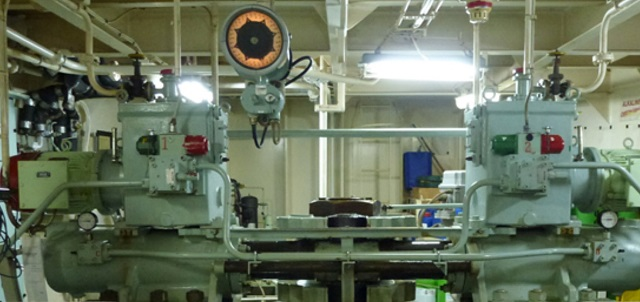
- Steering gear compartment must be separated from machinery spaces and readily accessible.
- Every vessel should be provided with main steering gear and auxiliary steering gear. The failure of one steering gear must not render the another one operation.
- Relief valves should be fitted to any part of the hydraulic system. Setting should not exceed designed pressure, i.e , 1.25 times of working pressure
Main steering gear and rudder stock shall be:
- Capable to place the rudder hard over from 35 deg. one side to 30 deg. another side not more than 28 second while running with full sea speed and full loaded draught. This should be done at maximum astern speed as also.
The auxiliary steering gear shall be:
- Appropriate strength and capable of steering the ship at navigational speed and could be brought to action in an emergency.
- Capable to put rudder from 15 deg. one side to 15 deg. another side not more than 60 second with the ship full loaded condition with speed not less than 7 knot.
• Rudder angle indicator should be independent from steering gear control system.
• Instruments of quick communication to be provided between Wheel house , E.R & Steering gear room.
• System oil low level alarm , audible and visible to be provided in Wheel house , E.R & steering room.
• Fluid used should be approved type and non freezing.
• With stock diameter 230 mm and above, an alternative power supply , capable to provide within 30 second, automatically, must be provided. Its capacity shall be at least 30 minutes for the ship 10000 gt and above. 10 minutes for other smaller.
• Electrical wiring system for steering gear shall be capable to accept 100 % load.
Solas 74 Amendments Chapter II: Regulation 29: Regulations of Steering Gear of Tankers, Chemical Tankers and LPG Gas Carriers:
10,000gt. over up to 100,000 dwt:
- Powered Main Steering gear.
- Powered independent auxiliary Steering gear, not allowed.
- 2 x 100% Power-actuating system required (Pump, actuator, piping).
- Time to regain steering after failure of certain components = 45 Secs.
- Alternative power supply to be on by 45 secs.
- Must have two-control system.
- Control system alarm to be fitted.
- Dedicated control system electric supply to be provided.
- Independent rudder angle indicator to be fitted.
- Handrails and non-skid surfaces to be provided in steering gear flat.
- Oil tank low level alarms to be fitted.
- Separate storage tanks to be fitted.
Regulation 29, Art. 1:
The main steering gear and the auxiliary steering gear should be so arranged that the failure of one of them will not render the other one inoperative.
Regulation 29, Art. 6.1.3:
The main steering gear is so organized that after a single failure in its piping system or in one of the power units the defect can be isolated so that steering capability can be maintained or speedily regained.
Regulation 29, Art. 12.2:
A low-level alarm for each and every hydraulic fluid reservoir to give the earliest practicable indication of hydraulic fluid leakage. Audible and visual alarms should be given on the navigating bridge and in the machinery space where they can be readily observed.
Regulation 29, Art. 12.3:
A tank of adequate volume to refill at least one power actuating system(Steering gear) including the reservoir, where the main steering gear is required to be power-operated. The tank should be joined by piping system in such a way that the hydraulic systems can be readily recharged from a position within the steering gear compartment and should be provided with a contents gauge.
The hydraulic fluid used for system should either be an ‘Artic’ type oil that is a good quality mineral oil or a water/antifreeze mixture. If oil is used it should have the following properties:
- Low pour point around -50°C.
- Low viscosity (30 Redwood sec. at 60°C).
- High viscosity index (110).
- High flash point (closed flash point 150°C).
- Non-sludge forming.
- Non-corrosive.
- Good lubricating properties but not too thin that will make gland scaling difficult.
- Density about 880 kg/m3 at 15.5°C.
Safeties:
- Overload alarm.. no trip
- 200% insulation on motor
- Self start after power failure
- Short circuit trip
- Phase failure alarm ..no trip
- Esb connection
- High LO temp alarm
- Relief valve
- Bypass valve
- LO low level alarm




